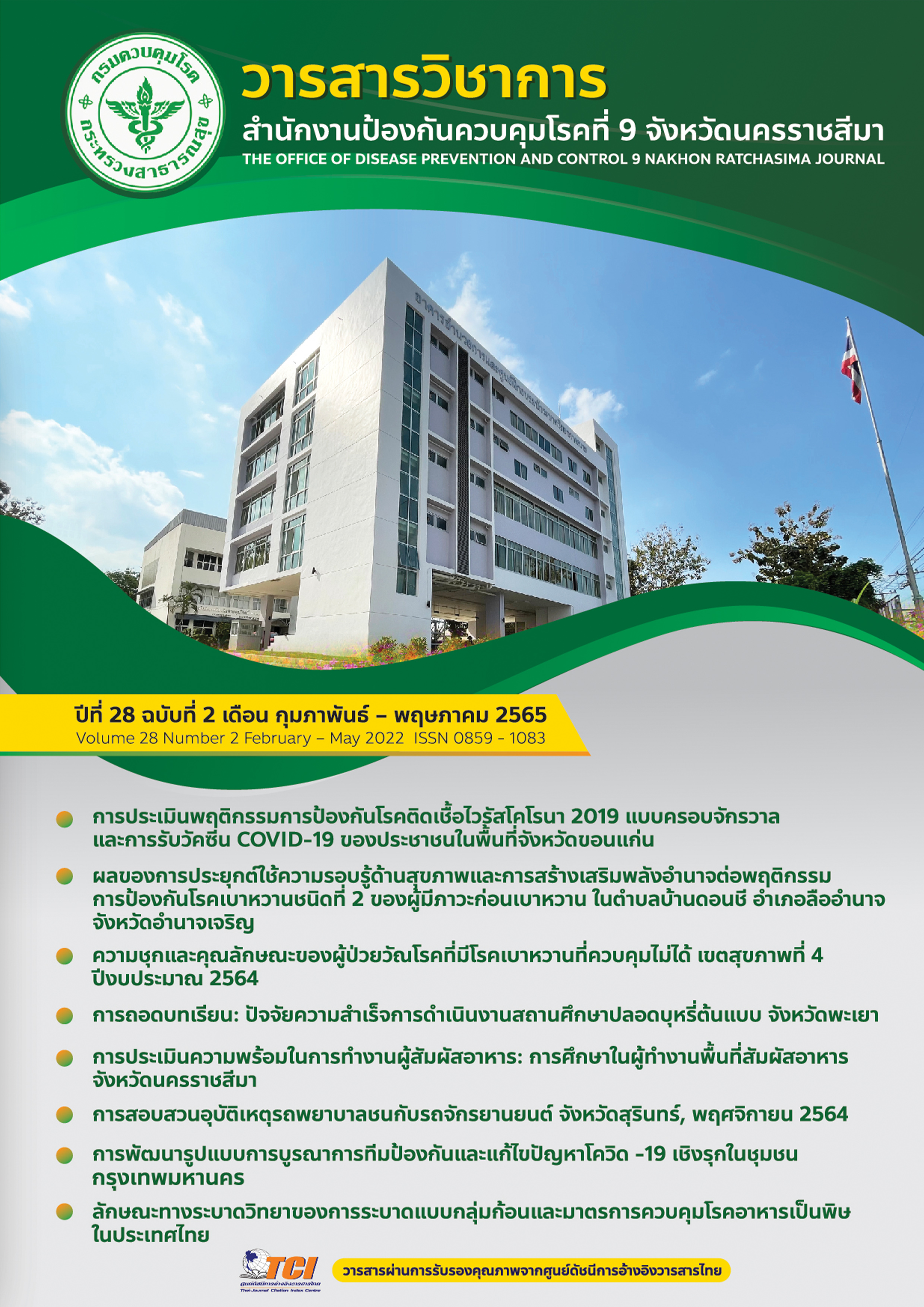Fit to work assessment as a food handler: A study of workers who work in food handling areas, Nakhon Ratchasima province
Keywords:
Food handler, Fitness for work, Food safety, Food borne pathogenAbstract
This study was a descriptive retrospective study. The purposes were to describe prevalence of enteric pathogens in stool among food handlers and medical evaluation in food handlers (fitness for work assessment). The data were collected by reviewing the patient's medical records between October 2020 and April 2021 at the occupational medicine clinic in a tertiary hospital, Nakhon Ratchasima province. There were 160 food handlers in this study. Mean age was 38 year-old (IQR 25 - 48), and the majority were female (77%). There were 105 food handlers (65.7%) working in a food handling area of the hospital. The results showed that 26 food handlers (16.3%) were found medical conditions, 7 (4.4%) from symptom & physical examination, 18 (11.5%) from positive rectal swab culture (most of them were Salmonella spp.) and 1 (0.6%) from abnormal chest x-ray (pulmonary infiltration). There was no abnormal findings in stool examination and Hepatitis A virus IgM antibody. The results of fitness for work assessment, there were 145 fit to work (90.6%), 6 (3.8%) were restriction from work and 9 (5.6%) were exclusion from work. Conclusion, rectal swab culture may have benefit for screening foodborne pathogen in infected food handlers. Medical conditions in food handlers should be managed appropriately by determining risk factors of transmission and severity of disease such as type of organisms, symptoms, hygiene, type of work and consumer group.
References
World Health Organization. World food safety day 2021: safe food now for a healthy tomorrow. Geneva: WHO; 2021.
Wheeler JG, Sethi D, Cowden JM, et al. Study of infectious intestinal disease in England: rates in the community, presenting to general practice, and reported to national surveillance. The Infectious Intestinal Disease Study Executive. BMJ 1999; 318: 1046–50.
Bonner C, Foley B, Wall P, Fitzgerald M. Analysis of outbreaks of infectious intestinal disease in Ireland: 1998 and 1999. Ir Med J 2001; 94: 140, 142–4.
Paulson DC. Get a handle on contamination. Food Qual 1996; April: 42-6.
Evans HS, Madden P, Douglas C, et al. General outbreaks of infectious intestinal disease in England and Wales: 1995 and 1996. Commun Dis Public Health 1998; 1: 165–71.
กฎกระทรวง สุขลักษณะของสถานที่จําหน่ายอาหาร พ.ศ. 2561. ราชกิจจานุเบกษา 20 มิ.ย.; 2561; 135 (ตอนที่ 42 ก): 19-25.
กฎกระทรวง ว่าด้วยสุขลักษณะของตลาด พ.ศ. 2551. ราชกิจจานุเบกษา 17 ม.ค..; 2551; 125 (ตอนที่ 13 ก): 5-7.
พระราชบัญญัติอาหาร พ.ศ. 2522. ราชกิจจานุเบกษา 13 พ.ค. 2522; 96 (ตอนที่ 79 ฉบับพิเศษ): 1-28.
Food and Agriculture Organization of the United Nations. General principles of food hygiene CXC 1-1969. Rev ed. Rom: FAO; 2020.
British Retail Consortium. Global standard food safety. London: BRC Global Standards; 2018.
สำนักงานมาตรฐานสินค้าเกษตรและอาหารแห่งชาติ. การปฏิบัติทางการเกษตรที่ดีสำหรับพืชอาหาร: มาตรฐานสินค้าเกษตร มกษ. 9001-2556. กรุงเทพฯ: สำนักงาน; 2556.
National Disease Surveillance Centre. Preventing foodborne disease: a focus on the infected food handler / National Disease Surveillance Centre [Online]. 2004 [cited 2022 Jan 21]. Available from: https:// www.lenus.ie/handle/10147/45140.
Biswal M, Khurana S, Taneja N, et al. Is routine medical examination of food handlers enough to ensure food safety in hospitals?. J Commun Dis 2012; 44: 139–44.
United States. Food and Drug Administration. Food code: 2017 recommendations of the United States Public Health Service, Food and Drug Administration. College Park, MD: U.S. Department of Health and Human Services, Public Health Service, Food and Drug Administration; 2017.
เอกชัย ชัยเดช. คู่มือการดําเนินงานสุขาภิบาลอาหาร ‘สถานที่จำหน่ายอาหาร’ ตามบทบัญญัติของกฎกระทรวงสุขลักษณะของสถานที่จําหน่ายอาหาร พ.ศ. 2561. พิมพ์ครั้งที่ 2. นนทบุรี: สำนักสุขาภิบาลอาหารและน้ำ กรมอนามัย; 2562.
Hellard ME, Sinclair MI, Hogg GG, Fairley CK. Prevalence of enteric pathogens among community based asymptomatic individuals. J Gastroenterol Hepatol 2000; 15: 290–3.
Kumar R, Dudeja P, Maurya A, Singh DK. Medical examination of food handlers: a missing link in food safety. Int J Med Sci Public Health 2019; 8: 728–32.
Public Health England. Salmonella data 2007 to 2016: National laboratory data for residents of England and Wales. London: Public Health England; 2018.
อังกูร เกิดพาณิช. Salmonella infections. เวชสารแพทย์ทหารบก 2549; 59: 231–46.
Techasaensiri C, Radhakrishnan A, Als D, Thisyakorn U. Typhoidal salmonella trends in Thailand. Am J Trop Med Hyg 2018; 99 (3_Suppl): 64–71.
Brachman PS. Control of communicable diseases manual, 17th edition. Am J Epidemiol 2001; 154: 783–4.
Gordon SC, Reddy KR, Schiff L, Schiff ER. Prolonged intrahepatic cholestasis secondary to acute hepatitis A. Ann Intern Med 1984; 101: 635–37.
Mandell GL, Douglas RG, Bennett JE, Dolin R, editors. Mandell, Douglas, and Bennett’s principles and practice of infectious diseases. 6th ed. New York: Elsevier/Churchill Livingstone; 2005.
Food Standards Agency. Food handlers: fitness to work. Regulatory guidance and best practice advice for food business operators [Online]. 2009 [cited 2021 Nov 23]. Available from: https://kku.world/ufwkb.
Threlfall EJ, Ward LR, Skinner JA, Smith HR, Lacey S. Ciprofloxacin-resistant Salmonella typhi and treatment failure. Lancet 1999; 353: 1590–1.
Pitkäjärvi T, Kujanne E, Sillantaka I, Lumio J. Norfloxacin and Salmonella excretion in acute gastroenteritis--a 6-month follow-up study. Scand J Infect Dis 1996; 28: 177–80.
Graninger W, Zedtwitz-Liebenstein K, Laferl H, Burgmann H. Quinolones in gastrointestinal infections. Chemotherapy 1996; 42 (Suppl 1): 43–53.
Shane AL. Red Book: 2006 Report of the Committee on Infectious Diseases, 27th Edition. Emerg Infect Dis 2006; 12: 2003–4.
Gotuzzo E, Guerra JG, Benavente L, et al. Use of norfloxacin to treat chronic typhoid carriers. J Infect Dis 1988; 157: 1221–5.
Frost AJ, O’Boyle D, Samuel JL. The isolation of Salmonella spp from feed lot cattle managed under different conditions before slaughter. Aust Vet J 1988; 65: 224–5.
World Health Organization. Health surveillance and management procedures for food-handling personnel: report of a WHO consultation. Geneva: WHO; 1989.
Khuri-Bulos NA, Abu Khalaf M, Shehabi A, Shami K. Foodhandler-associated Salmonella outbreak in a university hospital despite routine surveillance cultures of kitchen employees. Infect Control Hosp Epidemiol 1994; 15: 311–4.

Downloads
Published
How to Cite
Issue
Section
License
Copyright (c) 2022 The office of disease prevention and control 9th Nakhon Ratchasima

This work is licensed under a Creative Commons Attribution-NonCommercial-NoDerivatives 4.0 International License.
บทความที่ลงพิมพ์ในวารสารวิชาการสำนักงานป้องกันควบคุมโรคที่ 9 จังหวัดนครราชสีมา ถือว่าเป็น
ลิขสิทธิ์ สำนักงานป้องกันควบคุมโรคที่ 9 จังหวัดนครราชสีมา



